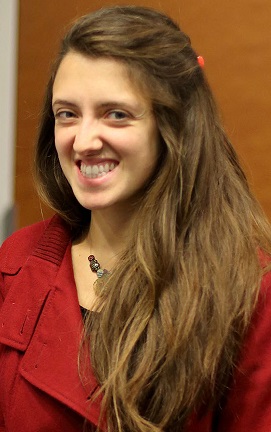CIE Researcher of Distinction, October 2017
Mariana Rius
Each month, the Center for Inclusive Education showcases the outstanding research being conducted by one of our talented scholars in our Research Café series. In addition, we recognize this scholar as a Researcher of Distinction and share the details of his/her journey to becoming an accomplished scholar. This month's Researcher of Distinction is Mariana Rius, PhD student in the School of Marine & Atmospheric Sciences. Mariana presented her work, ‘Horizontal gene transfer in the carotenoid production pathway of a non-photosynthetic marine protist’ on Monday, October 16, 2017.
MARIANA'S PATH INTO RESEARCH
Mariana Rius fell in love with marine science when her parents encouraged her to (not-so-willingly)
attend a John’s Hopkins University Center for Talented Youth (CTY) summer program
after eighth grade which focused entirely on the Chesapeake Bay oyster. She became
a marine conservation volunteer for Projects Abroad in Thailand following high school
graduation. Mariana completed her BS at the College of Charleston, SC. Her summers
were filled with diverse research internship projects at the NIH, where she continued
to do a two-year post-baccalaureate intramural research training award (IRTA) fellowship
in the National Eye Institute. She began her PhD in the School of Marine and Atmospheric
Sciences in August 2014 working on a very understudied
but critical protist found all over the world’s oceans. Mariana is a Turner Fellow
in the Center for Inclusive Education.
MARIANA's Current Research
Describe the work you presented for your Research Café.
In photosynthetic organisms, carotenoid pigments have functions for light-adapted lifestyles: light absorption and photoprotection. However, carotenoids are also produced in non-photosynthetic organisms, where both the function and evolution of these pigments is more mysterious. To gain insight into the function of carotenoids in non-photosynthetic organisms, I am studying the evolution of a gene involved in the first step of carotenoid biosynthesis in single-celled marine eukaryotes known as thraustochytrids. My phylogenetic analyses suggest that this gene, which encodes a phytoene synthase domain and is involved in condensing two geranylgeranyl pyrophosphate molecules to make phytoene, was acquired via horizontal gene transfer from bacteria. Having co-opted carotenogenesis via horizontal gene transfer suggests a significant fitness implication and potentially unique function pertaining to thraustochytrids, and potentially extending to other non-photosynthetic eukaryotes as well.
How did you become interested in research?
I am having trouble recalling how I became interested in research, as it seems this interest may have simply always been present.
What was the deciding factor for you to come to Stony Brook for your graduate studies?
I decided to come to Stony Brook for several reasons, one of which was being awarded the Turner Fellowship.
Are there any other projects, beyond your Research Café work, that you are currently working on?
Yes! I am currently working on developing a labyrinthulomycete transformation system, that will enable further understanding of the protists' biosynthetic pathways, physiology, and ecology.
What are your future goals?
In the immediate future, I plan to defend my proposal and advance to candidacy. In the less immediate future, I plan to graduate from Stony Brook University with a PhD in Oceanography.
What do you enjoy most about research?
I enjoy research because of the problem solving that is required in advancing projects. I enjoy research because each day is different.
